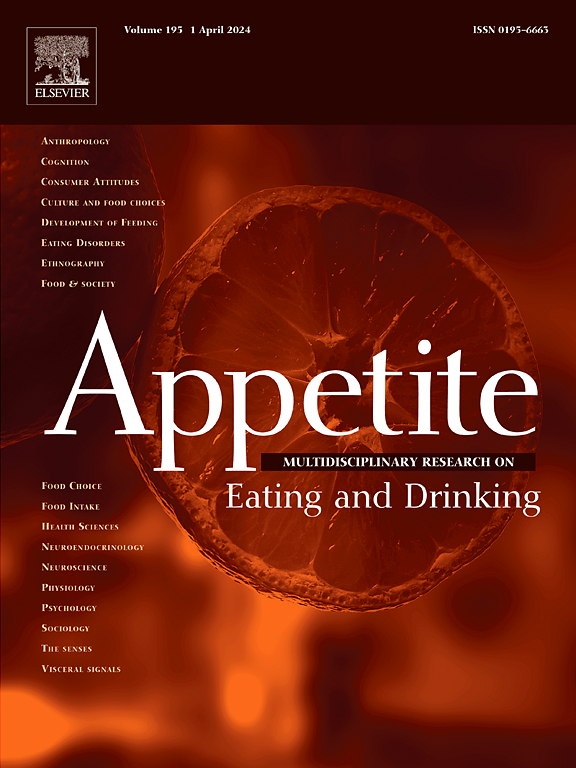没有证据表明暴露于环境食物气味后会产生目标引物或特定感官饱腹感效应。
IF 4.6
2区 医学
Q1 BEHAVIORAL SCIENCES
引用次数: 0
摘要
感官特异性饱腹感描述的是,相对于未食用的食物,食用食物后其味道的享乐价值会下降--这就是布丁肚子现象。研究还表明,对已食用食物的刺激动机也会下降。有几项研究报告称,短暂接触食物气味也会在不食用的情况下产生特定感觉的饱腹感效应,选择性地降低享乐评价和随后对高热量食物的选择。然而,另一些研究报告了环境气味的目标刺激效应,即短暂的隐性暴露会增加气味一致的食物选择的享乐价值。本研究旨在确定暴露于环境食物气味是否会提高或降低对相关食物的激励动机。参与者需要完成环境气味任务(38 人)或食物消费任务(40 人)。在这两项任务中,受试者都被随机分配到放纵食物组(巧克力)或非放纵食物组(橙子),并完成两组跨模态匹配握力任务。其中一个区块在接触气味/食用食物之前完成,另一个区块在接触气味/食用食物之后完成。相对于对照组刺激,握力传感器测量的是 "为赢得 "短暂呈现(33 或 200 毫秒)的这些食物的视觉图像所付出的努力。在这两项研究中,与对照组图像相比,参与者为赢得食物所付出的努力更大。虽然在接触环境气味后既没有发现饱腹感,也没有发现引物效应,但在食物消费研究中却发现了典型的感觉特异性饱腹感效应。也就是说,在食用巧克力后,对巧克力图像的动力明显下降,而对橙色刺激的动力却没有下降。虽然气味暴露结果的差异可以用暴露的浓度、时间和性质等因素来解释,但之前报道的气味诱发饱腹感和引物效应的稳健性仍然存在问题。本文章由计算机程序翻译,如有差异,请以英文原文为准。
No evidence for goal priming or sensory specific satiety effects following exposure to ambient food odours
Sensory-specific satiety describes a decline in hedonic value of the taste of a food as it is consumed, relative to a non-consumed food – the pudding tummy phenomenon. Incentive motivation towards consumed foods has also been shown to decline. Interestingly, several studies report that brief exposure to food odours can also produce a sensory-specific satiety effect, in the absence of consumption, selectively reducing hedonic ratings and subsequent high calorie food choices. Yet, other studies report goal-priming effects of ambient odours, in which brief implicit exposure increases the hedonic value of odour congruent food options. The present study aimed to determine whether exposure to ambient food odours would enhance or reduce incentive motivation for associated foods. Participants completed either an ambient odour (N = 38) or food consumption (N = 40) task. In both, participants were randomly assigned to an indulgent (chocolate) or non-indulgent (orange) food group and completed two blocks of a cross-modality matching grip-force task. One block was completed immediately before, the other immediately after, odour exposure/food consumption. A grip-force transducer measured effort exerted “to win” briefly presented (33 or 200ms) visual images of these foods, relative to control stimuli. In both studies, participants exerted greater effort to win the food items than control images. While neither satiety nor priming effects were found following ambient odour exposure, a classic sensory-specific satiety effect was found in the food consumption study. That is, force exerted for chocolate images declined significantly following chocolate consumption, in the absence of any decline in motivation for orange stimuli. While differences in odour exposure findings could be explained by factors such as concentration, timing, and nature of exposure, questions remain about the robustness of previously reported odour induced satiety and priming effects.
求助全文
通过发布文献求助,成功后即可免费获取论文全文。
去求助
来源期刊

Appetite
医学-行为科学
CiteScore
9.10
自引率
11.10%
发文量
566
审稿时长
13.4 weeks
期刊介绍:
Appetite is an international research journal specializing in cultural, social, psychological, sensory and physiological influences on the selection and intake of foods and drinks. It covers normal and disordered eating and drinking and welcomes studies of both human and non-human animal behaviour toward food. Appetite publishes research reports, reviews and commentaries. Thematic special issues appear regularly. From time to time the journal carries abstracts from professional meetings. Submissions to Appetite are expected to be based primarily on observations directly related to the selection and intake of foods and drinks; papers that are primarily focused on topics such as nutrition or obesity will not be considered unless they specifically make a novel scientific contribution to the understanding of appetite in line with the journal's aims and scope.
 求助内容:
求助内容: 应助结果提醒方式:
应助结果提醒方式:


